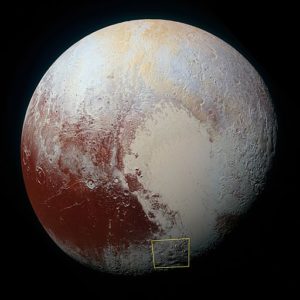
Global enhanced-color view of Pluto, with Wright Mons location indicated at bottom.
This is an edited, lower resolution version of a high resolution enhanced-color view of Pluto to provide context for a closeup image of the possible cryovolcano Wright Mons (PIA20155). The area covered by the closeup image of the mountain is indicated by the yellow rectangle (added by the uploader).
Pluto’s icy plains were expected; ice mountain ranges were a surprise.
VIDEO 53 sec. (Molten ice? It’s just water, or water mixed with other liquids, escaping from below the surface into the freezing atmosphere and re-freezing. There’s a “for fun” video sort of illustrating such a process at Page 4 of this article.)
New Horizons scientists expected to see icy plains on Pluto. Spectroscopic data had confirmed they would be composed of frozen nitrogen, methane, and carbon dioxide.
By the close-up view of the New Horizons flyby, mountains were seen to dot the expected plains, or icy lakes.
Finding 11,000-feet mountains has confirmed not only a cryovolcanic mountain-building process at work, but also, given the extreme cold, has confirmed that the substance forming the mountains is water, unseen by spectroscopic analysis. Watch this 53-second fly-over video, and see the explanation below.
The one highly detailed image of Pluto revealed today [July 16, 2015] was a small piece of the planet that has some very rough terrain and a clutch of mountains rising up to 11,000 feet (3½ km). That’s far too tall, notes John Spencer (Southwest Research Institute) to be big piles of the frozen nitrogen and methane that dominate Pluto’s spectrum. Instead, the underlying “rock” must be stiffer, sturdier water ice — something long suspected by cosmochemists but undetected in surface spectra.
Source: – See more at: Sky and Telescope.
Mountains of 11,000 feet (3,350 meters) are equivalent to some of the highest peaks in the Canadian Rockies, and generally indicate some kind of volcanic mountain-building process involving heating up of lower geological layers to thrust up material onto the frozen planet surface.
Pluto has 11,000 ft mountains made of water ice and is likely to have volcanoes and geyzers, the New Horizon team announced today.
Nasa said it had inspired a new generation of explorers as it released the closest ever pictures of the dwarf planet Pluto.
At a press conference last night the team revealed that Pluto, and its moon Charon, have been active and had experienced mountain building in the recent past. They found that Pluto had virtually no impact craters.
Scientists compared the size of Pluto’s ice mountains to the Rockies in North America.
“There are mountains in the Kuiper Belt,” said principal investigator Alan Stern. “We now have an isolated small planet that is showing activity after 4.5 billion years.
“The steep topography means the mountains must be made of water ice. We can be very sure the water is there in great abundance. It suggests that geysers and volcanoes are present.”
New Horizons scientist John Spencer, of the Southwest Research Institute said that it disproved the theory that icy worlds needed to be near the tidal pull of large planets to be geologically active.
“The most stunning thing is we have found is that this is a very young surface,” he said. It might be active right now. These mountains are quite spectacular. They are 11,000 ft high.
“We are seeing the bedrock of Pluto. Water ice is strong enough to hold up big mountains. This is the first time we have seen an icy world that isn’t orbiting another planet which has been active.
“You do not need tidal heating to power geological features on icy worlds That is a really new discovery that we just made this morning.”
Source: See the source Press Release here.
Ice volcanic activity, cryovolcanism, was first seen by Voyager 2 on Neptune’s Triton, in 1989. To see more about this process and its discovery, see the 5-minute VIDEO on the next page.



